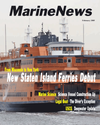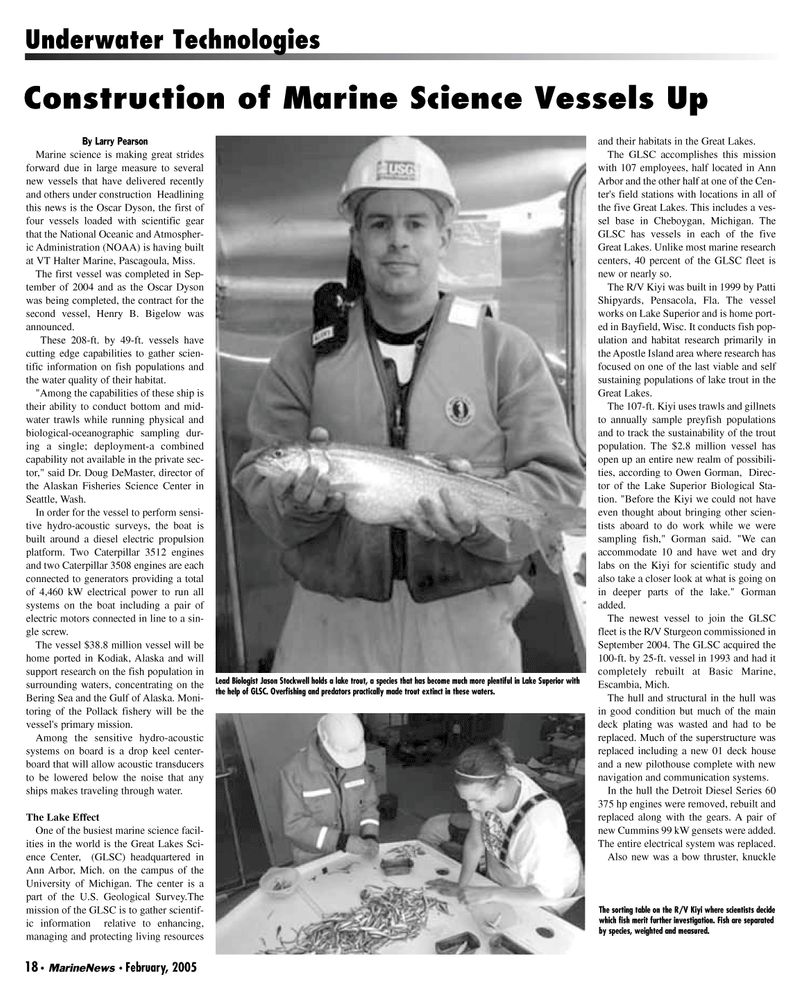
Page 18: of Marine News Magazine (February 2005)
Read this page in Pdf, Flash or Html5 edition of February 2005 Marine News Magazine
By Larry Pearson
Marine science is making great strides forward due in large measure to several new vessels that have delivered recently and others under construction Headlining this news is the Oscar Dyson, the first of four vessels loaded with scientific gear that the National Oceanic and Atmospher- ic Administration (NOAA) is having built at VT Halter Marine, Pascagoula, Miss.
The first vessel was completed in Sep- tember of 2004 and as the Oscar Dyson was being completed, the contract for the second vessel, Henry B. Bigelow was announced.
These 208-ft. by 49-ft. vessels have cutting edge capabilities to gather scien- tific information on fish populations and the water quality of their habitat. "Among the capabilities of these ship is their ability to conduct bottom and mid- water trawls while running physical and biological-oceanographic sampling dur- ing a single; deployment-a combined capability not available in the private sec- tor," said Dr. Doug DeMaster, director of the Alaskan Fisheries Science Center in
Seattle, Wash.
In order for the vessel to perform sensi- tive hydro-acoustic surveys, the boat is built around a diesel electric propulsion platform. Two Caterpillar 3512 engines and two Caterpillar 3508 engines are each connected to generators providing a total of 4,460 kW electrical power to run all systems on the boat including a pair of electric motors connected in line to a sin- gle screw.
The vessel $38.8 million vessel will be home ported in Kodiak, Alaska and will support research on the fish population in surrounding waters, concentrating on the
Bering Sea and the Gulf of Alaska. Moni- toring of the Pollack fishery will be the vessel's primary mission.
Among the sensitive hydro-acoustic systems on board is a drop keel center- board that will allow acoustic transducers to be lowered below the noise that any ships makes traveling through water.
The Lake Effect
One of the busiest marine science facil- ities in the world is the Great Lakes Sci- ence Center, (GLSC) headquartered in
Ann Arbor, Mich. on the campus of the
University of Michigan. The center is a part of the U.S. Geological Survey.The mission of the GLSC is to gather scientif- ic information relative to enhancing, managing and protecting living resources and their habitats in the Great Lakes.
The GLSC accomplishes this mission with 107 employees, half located in Ann
Arbor and the other half at one of the Cen- ter's field stations with locations in all of the five Great Lakes. This includes a ves- sel base in Cheboygan, Michigan. The
GLSC has vessels in each of the five
Great Lakes. Unlike most marine research centers, 40 percent of the GLSC fleet is new or nearly so.
The R/V Kiyi was built in 1999 by Patti
Shipyards, Pensacola, Fla. The vessel works on Lake Superior and is home port- ed in Bayfield, Wisc. It conducts fish pop- ulation and habitat research primarily in the Apostle Island area where research has focused on one of the last viable and self sustaining populations of lake trout in the
Great Lakes.
The 107-ft. Kiyi uses trawls and gillnets to annually sample preyfish populations and to track the sustainability of the trout population. The $2.8 million vessel has open up an entire new realm of possibili- ties, according to Owen Gorman, Direc- tor of the Lake Superior Biological Sta- tion. "Before the Kiyi we could not have even thought about bringing other scien- tists aboard to do work while we were sampling fish," Gorman said. "We can accommodate 10 and have wet and dry labs on the Kiyi for scientific study and also take a closer look at what is going on in deeper parts of the lake." Gorman added.
The newest vessel to join the GLSC fleet is the R/V Sturgeon commissioned in
September 2004. The GLSC acquired the 100-ft. by 25-ft. vessel in 1993 and had it completely rebuilt at Basic Marine,
Escambia, Mich.
The hull and structural in the hull was in good condition but much of the main deck plating was wasted and had to be replaced. Much of the superstructure was replaced including a new 01 deck house and a new pilothouse complete with new navigation and communication systems.
In the hull the Detroit Diesel Series 60 375 hp engines were removed, rebuilt and replaced along with the gears. A pair of new Cummins 99 kW gensets were added.
The entire electrical system was replaced.
Also new was a bow thruster, knuckle 18 • MarineNews • February, 2005
Underwater Technologies
Construction of Marine Science Vessels Up
Lead Biologist Jason Stockwell holds a lake trout, a species that has become much more plentiful in Lake Superior with the help of GLSC. Overfishing and predators practically made trout extinct in these waters.
The sorting table on the R/V Kiyi where scientists decide which fish merit further investigation. Fish are separated by species, weighted and measured.
MN FEB05 (17-24).qxd 1/26/2005 4:31 PM Page 18

 17
17

 19
19
